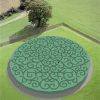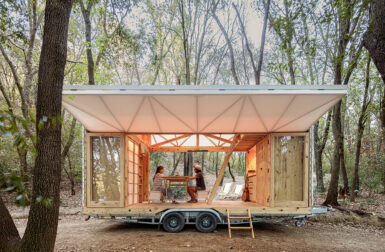When I first heard about the YLighting Marcel Wanders Pattern Play contest I thought it was such a great idea. We all know Marcel Wanders is famous not only for his designs but the intricate patterns that he uses in his work. In fact, he designed some to be used as tattoos last year!

This time, he partnered with YLighting and offered the pattern from his Can Can Pendant for FLOS and they asked designers to use the pattern in unexpected and interesting ways. The contest was open to designers from all over the world, and hundreds of submissions were gathered. The winner — Gregory Van Horn from Los Angeles — received $2,500 and a Can Can light! After seeing how creative the submissions were, I thought it would be fun to look at the top designs that came out of the contest.
Marcel Wanders, together with Piero Gandini, CEO, FLOS and Sean Callahan, CEO, YLighting, selected the three top winners and five runners up and there are definitely some outside-the-box designs here.

First Place: Can Can Labyrinth by Gregory Van Horn in Los Angeles
Gregory, who designs sets for TV and film productions in LA, currently working on ABC’s Private Practice, created a meditation garden constructed of 5’6” tall box hedges; negative space creates the pattern. “Lately, I have been interested in about medieval labyrinths and have been reading a lot about how they were used for meditation,” he said. What drew him to the Marcel Wanders pattern is the way it gave the sense of repetition and no-repetition at the same time. He wanted to blow up the scale to enhance this experience with the pattern.
Marcel Wanders explains why he chose Gregory’s design as the winner: “I chose the winning design ‘Can Can Labyrinth’ as it took the pattern as surface and brought it to life by making it an experience. The design reflects the underlying craziness and playfulness of the competition and doesn’t take itself too seriously. It is romantic and imaginative and is something I would love to see.”

Second Place: Dalmaticancan by Jeddah Stanley in Australia
Jeddah said positive and negative patterns in nature defined her idea for the entry. “I am intrigued by positive and negative elements in the natural and man made world. Focus on the positive space and you may miss the detail in the negative. When viewed at a glance, nothing appears out of place, take a closer look and a beautiful pattern appears,” she said.
“Marcel, Piero and I were drawn to the idea of the unexpected. Nothing is more unexpected than the possibility that this intricate and man-made design might somehow be encountered in nature,” said Sean Callahan about this design’s selection.

Third Place: Can Can tea bag by Alexey Vesselov in Russia
A graduate of Academy of Art and Design, Alexey is a furniture and interior designer in St Petersburg. About his inspiration for the winning entry, Alexey says he thought about lace and objects that are fine-looking and useful at the same time. “I remembered pyramidal tea bags, and wanted to invent something like this for Pattern Play Contest. At first I thought about dodecahedron or icosahedron — complicated 3d structures, but finally set my choice on cube. This form provides a better look to a pattern and it’s simpler.”
What motivated his design was to find a simpler and more refined way for a common everyday activity, tea drinking in this case, an activity he enjoys daily. “I always liked to look at my tea through a transparent pot or cup. With a help of this pattern the view in the pot becomes more expressive,” said Alexey. “I believe, that the age of minimalism in art and design has gone, and now we can freely use our heritage together with modern technologies and aesthetics.”

Runner Up: Ant Glue Trap by Oscar Salguero in Virginia
Oscar is a 4th year industrial design student at Virginia Tech. He made the contest his winter break project. What Oscar found interesting about the pattern was the hidden quality. “You have to come close to it to truly appreciate it.” He started thinking about how to use it in an unexpected way and turned to nature. As a designer, Oscar is interested in science-related topics such as bacteria and insects.
For a class he was researching industrially made traps for bug infestations. He also saw flypaper used in a farm to capture food flies. He was intrigued by how something grotesque could turn into something beautiful through design. The ant-trap features the pattern in sticky material. As more and more ants are caught, the beautiful pattern emerges. Once the pattern is complete, the user would also know that the trap is full and it’s time to switch to a new trap.

Runner Up: Drain cover by Mahsa Vanaki in Oakland
Mahsa has an architectural background and owns a design studio that does research fabrication, with 3D laser cutting capabilities. As she was contemplating this on a cold gray day, she was struck by the contrast of what was in her mind (warm chocolate) and what was surrounding her (cold, gray city). To play with the idea, she placed a laser-cut version of the pattern made from 1/8″ thick wood at the mouth of a leaking drainpipe she saw on the side of the road. She was not going to submit this, but was curious about the concept. She then realized that the diameter of the pattern matched the pipe perfectly by chance and this interested her. Eventually she was convinced that the resulting pictures were more fitting with her mood and decided to take a chance.

Runner Up: Can Can Living Wall by Lauren Vrbin in Pittsburgh
“The never ending organic flow of the Can Can pattern tied to the fresh vintage design of the pendant attracted me. Similar to how the Can Can light brings refreshing life to interiors, I wanted create something that could take that concept and bring life to an otherwise ordinary space,” said Lauren of her inspiration for the entry design. She noticed contrasting elements within both the Can Can pattern and her patio wall. “My outdoor patio design displays a variety of plants that could only be seen in detail while sitting or standing close, bringing people from distances to the building similar to the effect of the Can Can light.”

Runner Up: A Marcel Wanders bicycle by Melanie in New York
Melanie, a fashion industry professional in NYC, said she was moved by the organic composition of the Can Can pattern. “It reminds me of New York’s Central Park; designed with absolutely no sharp angles or edges it carries on in a flowing manner leading you to many similar yet different areas, all with fantastic surprises and not an end in sight.”
When creating per entry, she wanted to merge a graphic two-dimensional form with a mechanical three-dimensional design. Melanie calls herself “a complete sucker” for bicycles. “I immediately knew I would use the spokes of a road bike as the perfect position for the Can Can design. It just made sense.”

Runner Up: The forgotten Pac-Man level by Bradley in Indiana
Bradley describes the pattern designed by Marcel Wanders as “gracefully chaotic.” The curves and intersections come together nicely in the overall circular design. He liked the near symmetry with the small break in it near the top of the pattern. “That little difference adds character to the design that not everyone will see, but it is a nice touch that those that do notice will appreciate.” The design also reminded him of doodles he has done of wandering paths, and it was therefore close to home. The dark color palate and simple background, he said, helped the focus remain on the pattern.
“I wanted to come up with a design that would be a completely unique use of the Can Can pattern. I have long been a fan of video games. For better or worse they have been a part of my life, and have made an impact on me. When I was working on ideas that would fit with the wide ‘track’ of the pattern, somehow the thought of the old Pac-man levels came to me. With some tweaking to get that lovely 80’s look, I think we have a pretty good looking, and large, level for the game.”







